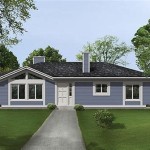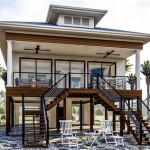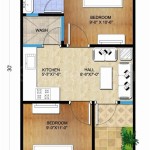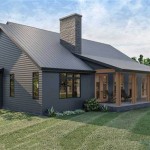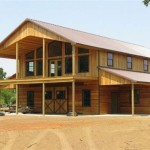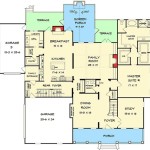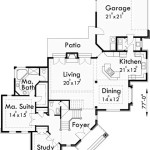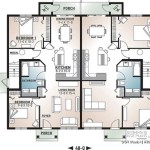Single-Story Lake House Plans: Designing Your Lakeside Retreat
Single-story lake house plans offer a compelling combination of accessibility, seamless indoor-outdoor living, and captivating views. The allure of a lakeside home lies in its ability to integrate with nature, and a single-story design maximizes this connection. These plans cater to a wide range of homeowners, from those seeking a retirement haven to families desiring a vacation getaway. The absence of stairs makes them particularly attractive for individuals with mobility concerns or those planning for aging in place. Furthermore, the layout promotes a sense of openness and flow, enhancing the overall living experience.
When embarking on the journey of selecting or crafting single-story lake house plans, meticulous attention to detail is crucial. Considerations extend beyond square footage and architectural style to encompass site orientation, local building codes, and personal preferences. The goal is to create a space that not only complements the surrounding environment but also fulfills the specific needs and desires of the occupants. This requires a comprehensive understanding of design principles, construction techniques, and the unique challenges presented by a lakeside location.
Maximizing Views and Natural Light
A primary advantage of lakeside living is the opportunity to enjoy breathtaking views. Single-story lake house plans should be designed to capitalize on this asset. This involves strategic placement of windows, doors, and outdoor living spaces to frame the water and surrounding landscape. Large windows, sliding glass doors, and expansive decks or patios can seamlessly blend the indoor and outdoor environments, creating a sense of spaciousness and connection to nature.
Beyond the aesthetic appeal, maximizing natural light is essential for creating a comfortable and energy-efficient home. Proper orientation of the house in relation to the sun's path can significantly reduce the need for artificial lighting and heating, thereby lowering energy bills and minimizing environmental impact. South-facing windows are ideal for capturing sunlight during the winter months, while strategically placed overhangs and awnings can provide shade during the summer. Skylights can also be incorporated to bring natural light into interior spaces that may not have direct access to exterior windows.
Consideration should also be given to the type of glass used in windows and doors. Low-E (low-emissivity) glass can help to reduce heat transfer, keeping the house cooler in the summer and warmer in the winter. Tinted glass can also be used to minimize glare and protect furniture from fading. Furthermore, the placement of windows should take into account privacy concerns, particularly if the lake house is located in a densely populated area. Strategic landscaping can provide additional screening and enhance the sense of seclusion.
Designing for Accessibility and Functionality
Single-story lake house plans inherently offer greater accessibility compared to multi-story designs. The absence of stairs eliminates a major barrier for individuals with mobility limitations, making the home more suitable for aging in place or accommodating guests with disabilities. However, designing for accessibility goes beyond simply removing stairs. Wider doorways, hallways, and turning spaces are essential for wheelchair maneuverability. Lever-style door handles and grab bars in bathrooms can also enhance accessibility and safety.
Functionality is another key consideration in single-story lake house design. The layout should be optimized for efficient use of space and ease of movement. Open-concept floor plans can create a sense of spaciousness and promote social interaction. A well-designed kitchen with ample counter space and storage is essential for preparing meals and entertaining guests. Mudrooms or entryways can provide a convenient space for storing outdoor gear and preventing dirt from being tracked into the house. Dedicated laundry rooms can also improve functionality and organization.
Furthermore, the design should take into account the specific needs of the homeowner. For example, those who enjoy boating or fishing may want to incorporate a boathouse or dock into the design. Others may prefer a large deck or patio for outdoor entertaining. The layout should also consider storage needs, particularly for seasonal items such as patio furniture, water sports equipment, and holiday decorations. Ample closet space, attic storage, or a detached garage can help to keep the house clutter-free and organized.
Selecting Materials and Finishes for a Lakeside Environment
The choice of materials and finishes is crucial for creating a durable, aesthetically pleasing, and environmentally responsible lake house. Materials should be selected to withstand the harsh conditions of a lakeside environment, including exposure to moisture, sunlight, and wind. Durable and low-maintenance options are particularly desirable, as they can minimize upkeep and extend the lifespan of the home.
For exterior cladding, options such as fiber cement siding, brick, stone, and wood siding are all viable choices. Fiber cement siding is a popular choice due to its durability, resistance to pests, and ability to mimic the look of wood. Brick and stone offer a timeless and low-maintenance option, while wood siding provides a natural and aesthetically pleasing look. However, wood siding requires regular maintenance to prevent rot and insect damage. Roofing materials should also be selected for their durability and resistance to weather. Asphalt shingles, metal roofing, and tile roofing are all common choices.
Interior finishes should be selected to complement the overall design aesthetic and create a comfortable living environment. Hardwood flooring is a popular choice for its durability and warmth, while tile flooring is a practical option for bathrooms and kitchens. Natural stone countertops add a touch of elegance and durability to kitchens and bathrooms. When selecting paint colors, consider using light and airy colors to create a sense of spaciousness and reflect natural light. Incorporating natural elements such as wood, stone, and plants can further enhance the connection to the surrounding environment. Furthermore, it is important to select materials and finishes that are environmentally friendly and sustainable. Low-VOC paints, recycled-content flooring, and energy-efficient appliances can help to reduce the environmental impact of the home.
Site considerations extend beyond the immediate footprint of the house. Landscaping should be carefully planned to complement the architecture and enhance the natural beauty of the surroundings. Native plants are a good choice, as they are adapted to the local climate and require less maintenance. Erosion control measures may be necessary to protect the shoreline and prevent soil erosion. Docks and piers should be designed to minimize environmental impact and comply with local regulations. Proper drainage is also essential to prevent flooding and protect the foundation of the house.
Designing a single-story lake house requires careful consideration of numerous factors, from maximizing views and natural light to designing for accessibility and functionality. By selecting appropriate materials and finishes and paying attention to site considerations, it is possible to create a beautiful, durable, and environmentally responsible lake house that provides a comfortable and enjoyable living experience for years to come. A detailed plan, executed with precision, results in a lakeside retreat that harmonizes with its environment and caters to the lifestyle of its occupants.

1 Story Craftsman Style Lake House Plan With Wrap Around Deck Pelican Bay Plans Small Houses

Best Lake House Plans Waterfront Cottage Simple Designs

Lake House Plans Blog Homeplans Com

Builder News 120 Lake House Plans

Open Concept Small Lake House Plans Houseplans Blog Com

Lake House Designs And More Blog Eplans Com

Lake House Plan 2 Bedrms Baths 1922 Sq Ft 138 1003

House The Lakeside Plan Green Builder Plans

Best Lake House Plans Waterfront Cottage Simple Designs

Lake Style House Plan 7544 The Lakeshore

